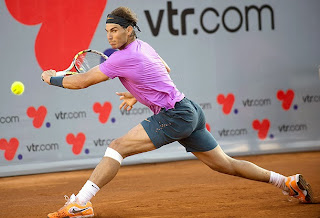In a report in The Daily Mail, Nadal’s team opened up about his use of platelet-rich plasma therapy (PRP) during his knee rehabilitation. The treatment involves taking a small vial of a person’s blood, spinning it in a centrifuge to separate the platelet-rich cells, which carry growth factors that are believed to have a regenerative effect, and reinjecting those cells into the site of the injury to speed up recovery.
According to Scientific American, the procedure was first used for sports-related injuries in 2008. Bloomberg estimates that thousands of athletes have undergone the procedure, including Tiger Woods, Kobe Bryant and Troy Polamalu. The World Anti-Doping Agency banned the procedure in 2010 because of concerns over its performance-enhancing effects, but legalized it a year later after a review of literature found there was no evidence that it was in fact performance-enhancing.
Here’s a snippet from The Daily Mail story about what it describes as PRP’s possible “interesting future”:
According to papers published in the American Journal of Sports Medicine this summer it [PRP] may have much wider benefits to performance. Doctors Amy Wasterlain and Jason Dragoo found that Human Growth Hormone ‘increases dramatically within the first 24 hours after PRP infiltration’. They said that their trials had shown its effects can include ‘rocketing both anabolic and catabolic growth factor release’.Speaking to reporters at the Shanghai Masters, Nadal addressed the report and clarified that the procedure actually wasn’t as effective during his most recent injury.
They concluded that ‘our observation of statistically significant increases in multiple growth factors over multiple days after local PRP treatment points to a real systemic effect that cannot simply be ignored.’
The topic is sure to be among those discussed at WADA’s World Conference in Johannesburg next month.
How much of a benefit this might be to Nadal or any other athlete cannot be fully known, the same as with what part, if any, it might play in the ability of some to recover incredibly quickly from gruelling matches and bounce back for the next one.
“PRP worked unbelievable on my knee before, in 2010, 2009,” he said. “[In] 2009 I had to pull out of Wimbledon, then I came back, but I still I have pain. Just after Monte Carlo, I did for the first time the PRP treatment for my knee, but it was on the top of the knee, not down [below]. Worked unbelievable. I recovered 100 percent in a very short period of time during the PRP treatment.
“With the injury I have now, I did it. I tried it a lot of times, and it really didn’t help me a lot.”
The Daily Mail report also mentions Nadal’s use of an anti-gravity treadmill machine, which allowed him to stay fit during his injury layoff without putting too much strain on his knee.
Despite the seven months of rest and aggressive treatment and therapy, Nadal told reporters that he and his team didn’t find any magical recovery method. He still experiences pain in his knee, but he’s now learned how to manage it.
“The feeling on the knee is not 100 percent perfect,” he said. “But the feeling on the knee is very good for me because even if I have pain a lot of days, the pain is not limiting my movements. That’s the most important thing. I am playing with no limitations. I am free when I am playing. Even if I have pain, I am able to control that pain — something in the past I was not able to control that pain, so I couldn’t play.”
Nadal is seeking to win his record sixth ATP Masters 1000 tournament of the season this week. He’s never won this tournament since it moved from Madrid in 2009. Whether he wins it this year or not, he’s hopeful, if not confident, that he’ll have many more chances.
“[F]or the last five years, seems like a lot of people are talking like I will not be able to play long the way that I play,” he said. “But I am here again at 27 years old, and I really hope to have the chance to be here for a lot of more years.”
Source: http://tennis.si.com/2013/10/08/rafael-nadal-knee-injury-recovery/

Aucun commentaire:
Enregistrer un commentaire